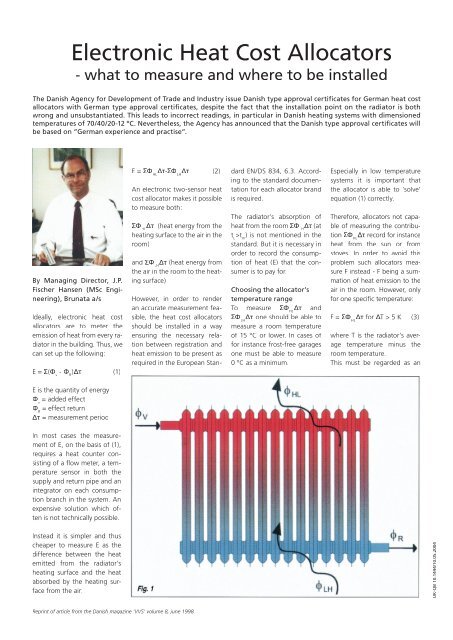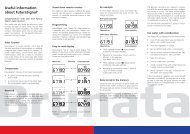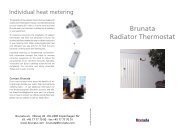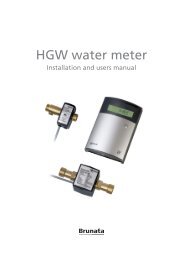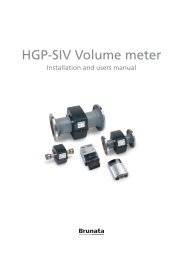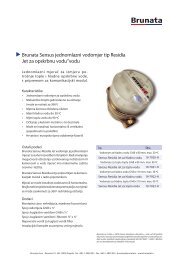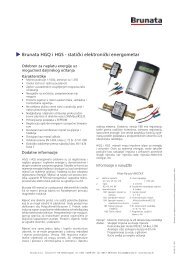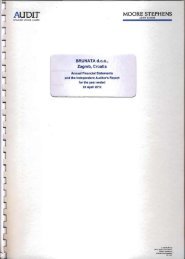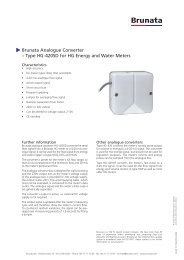Electronic Heat Cost Allocators - Brunata
Electronic Heat Cost Allocators - Brunata
Electronic Heat Cost Allocators - Brunata
You also want an ePaper? Increase the reach of your titles
YUMPU automatically turns print PDFs into web optimized ePapers that Google loves.
<strong>Electronic</strong> <strong>Heat</strong> <strong>Cost</strong> <strong>Allocators</strong><br />
- what to measure and where to be installed<br />
The Danish Agency for Development of Trade and Industry issue Danish type approval certificates for German heat cost<br />
allocators with German type approval certificates, despite the fact that the installation point on the radiator is both<br />
wrong and unsubstantiated. This leads to incorrect readings, in particular in Danish heating systems with dimensioned<br />
temperatures of 70/40/20-12 ºC. Nevertheless, the Agency has announced that the Danish type approval certificates will<br />
be based on ”German experience and practise”.<br />
By Managing Director, J.P.<br />
Fischer Hansen (MSc Engineering),<br />
<strong>Brunata</strong> a/s<br />
Ideally, electronic heat cost<br />
allocators are to meter the<br />
emission of heat from every radiator<br />
in the building. Thus, we<br />
can set up the following:<br />
E = Σ(Φ v<br />
- Φ R<br />
)Δτ (1)<br />
E = ΣΦ HL<br />
Δτ-ΣΦ LH<br />
Δτ (2)<br />
An electronic two-sensor heat<br />
cost allocator makes it possible<br />
to measure both:<br />
ΣΦ HL<br />
Δτ (heat energy from the<br />
heating surface to the air in the<br />
room)<br />
and ΣΦ LH<br />
Δτ (heat energy from<br />
the air in the room to the heating<br />
surface)<br />
However, in order to render<br />
an accurate measurement feasible,<br />
the heat cost allocators<br />
should be installed in a way<br />
ensuring the necessary relation<br />
between registration and<br />
heat emission to be present as<br />
required in the European Standard<br />
EN/DS 834, 6.3. According<br />
to the standard documentation<br />
for each allocator brand<br />
is required.<br />
The radiator’s absorption of<br />
heat from the room ΣΦ LH<br />
Δτ (at<br />
t L<br />
>t m<br />
) is not mentioned in the<br />
standard. But it is necessary in<br />
order to record the consumption<br />
of heat (E) that the consumer<br />
is to pay for.<br />
Choosing the allocator’s<br />
temperature range<br />
To measure ΣΦ HL<br />
Δτ and<br />
ΣΦ LH<br />
Δτ one should be able to<br />
measure a room temperature<br />
of 15 ºC or lower. In cases of<br />
for instance frost-free garages<br />
one must be able to measure<br />
0 ºC as a minimum.<br />
Especially in low temperature<br />
systems it is important that<br />
the allocator is able to ‘solve’<br />
equation (1) correctly.<br />
Therefore, allocators not capable<br />
of measuring the contribution<br />
ΣΦ HL<br />
Δτ record for instance<br />
heat from the sun or from<br />
stoves. In order to avoid this<br />
problem such allocators measure<br />
F instead - F being a summation<br />
of heat emission to the<br />
air in the room. However, only<br />
for one specific temperature:<br />
F = ΣΦ HL<br />
Δτ for ΔT > 5 K (3)<br />
where T is the radiator’s average<br />
temperature minus the<br />
room temperature.<br />
This must be regarded as an<br />
E is the quantity of energy<br />
Φ v<br />
= added effect<br />
Φ R<br />
= effect return<br />
Δτ = measurement period<br />
In most cases the measurement<br />
of E, on the basis of (1),<br />
requires a heat counter consisting<br />
of a flow meter, a temperature<br />
sensor in both the<br />
supply and return pipe and an<br />
integrator on each consumption<br />
branch in the system. An<br />
expensive solution which often<br />
is not technically possible.<br />
Instead it is simpler and thus<br />
cheaper to measure E as the<br />
difference between the heat<br />
emitted from the radiator’s<br />
heating surface and the heat<br />
absorbed by the heating surface<br />
from the air:<br />
UK-QB 10.1444/10.05.2004<br />
Reprint of article from the Danish magazine ‘VVS’ volume 8, june 1998
E/R = emitted energy from the radiator per registered unit on the allocator<br />
M/Mn= Volume flow through the radiator in proportion to the norm volume flow<br />
(90/70/20). Radiator and allocator exponent = 1.3<br />
‘emergency solution’ which<br />
leads to significant registration<br />
errors – in particular when it<br />
comes to low temperature systems.<br />
Due to the radiators’ low<br />
average temperatures a considerable<br />
part of the heat emitted<br />
at low capacity (typically during<br />
autumn and spring) will not be<br />
recorded. Still, a considerable<br />
part of the heat absorbed during<br />
warm summer periods and<br />
later on emitted will be registered<br />
as consumption.<br />
The allocators are to be approved<br />
by accredited laboratories.<br />
These laboratories are<br />
designed and accredited for<br />
allocator testing (3). But they<br />
are not able to test allocators<br />
using (2).<br />
Documentation for the<br />
installation point<br />
In connection with new Danish<br />
requirements on type approvals,<br />
German laboratories have<br />
turned out to have tested and<br />
approved allocators without<br />
checking wheather the installation<br />
point, as stated by the<br />
manufacturer, is correct. Even if,<br />
according to the standard, this<br />
must be certified.<br />
All German allocators are installed<br />
in 75 % of the radiator<br />
height – regardless of make.<br />
Used as “documentation” for<br />
this installation point is an article<br />
in the German magazine<br />
“Heizung, Lüftung und Haustechnik”:<br />
Montageart für HKV<br />
nach dem Verdunstungsprinzip<br />
(HLH 1980/6). I.e. an article<br />
about evaporative heat cost allocators.<br />
All German electronic<br />
two-sensor allocators are also<br />
installed in this incorrect position<br />
of height, as the high point<br />
of installation for evaporative<br />
allocators must compensate for<br />
decreased registration at low<br />
capacity due to the relation to<br />
the air temperature – a problem<br />
which does not exist for electronic<br />
allocators.<br />
This has been clearly confirmed<br />
throughout the last 30<br />
years, during which <strong>Brunata</strong><br />
has carried out a number of<br />
tests on the correct installation<br />
point. It was, by the way,<br />
<strong>Brunata</strong>’s own tests on the installation<br />
point of evaporative<br />
heat cost allocators which lead<br />
to the tests referred to in HLH<br />
1980/6. <strong>Brunata</strong>’s tests on<br />
electronic heat cost allocators<br />
can be seen in figure 2, which<br />
shows three different installation<br />
heights.<br />
The Danish Agency for Development<br />
of Trade and Industry<br />
issue type approval certificates<br />
based on German type approvals,<br />
but they do not ask for<br />
proper documentation as to<br />
the point of installation. Thus,<br />
Danish customers will have to<br />
ask for special documentation.<br />
When the installation point is<br />
too high it implies that consum-<br />
ers do not receive the reduction<br />
in their heating bill to which<br />
they are entitled if lowering<br />
their consumption of heat. As<br />
a result a significant part of the<br />
incentive to lower ones heat<br />
consumption disappears. In<br />
consequence of this the cooling<br />
may become inadequate in the<br />
district heating system.<br />
Conclusion<br />
At the next revision the European<br />
Standard must be changed.<br />
It ought to focus more on allocators<br />
measuring the heat<br />
emission E. The present standard<br />
focuses on German conditions<br />
with relatively high dimensioned<br />
temperatures for<br />
heating systems (90/70/20).<br />
A revised standard should open<br />
the possibility for designing allocators<br />
whose specifications<br />
correspond to the conditions<br />
under which they are used, for<br />
instance dimensioned temperatures<br />
70/40/20, which is the<br />
case in Denmark. Furthermore,<br />
the administrative practice<br />
must be tightened so that allocators<br />
in non-compliance with<br />
the standard are not approved<br />
by national authorities.


